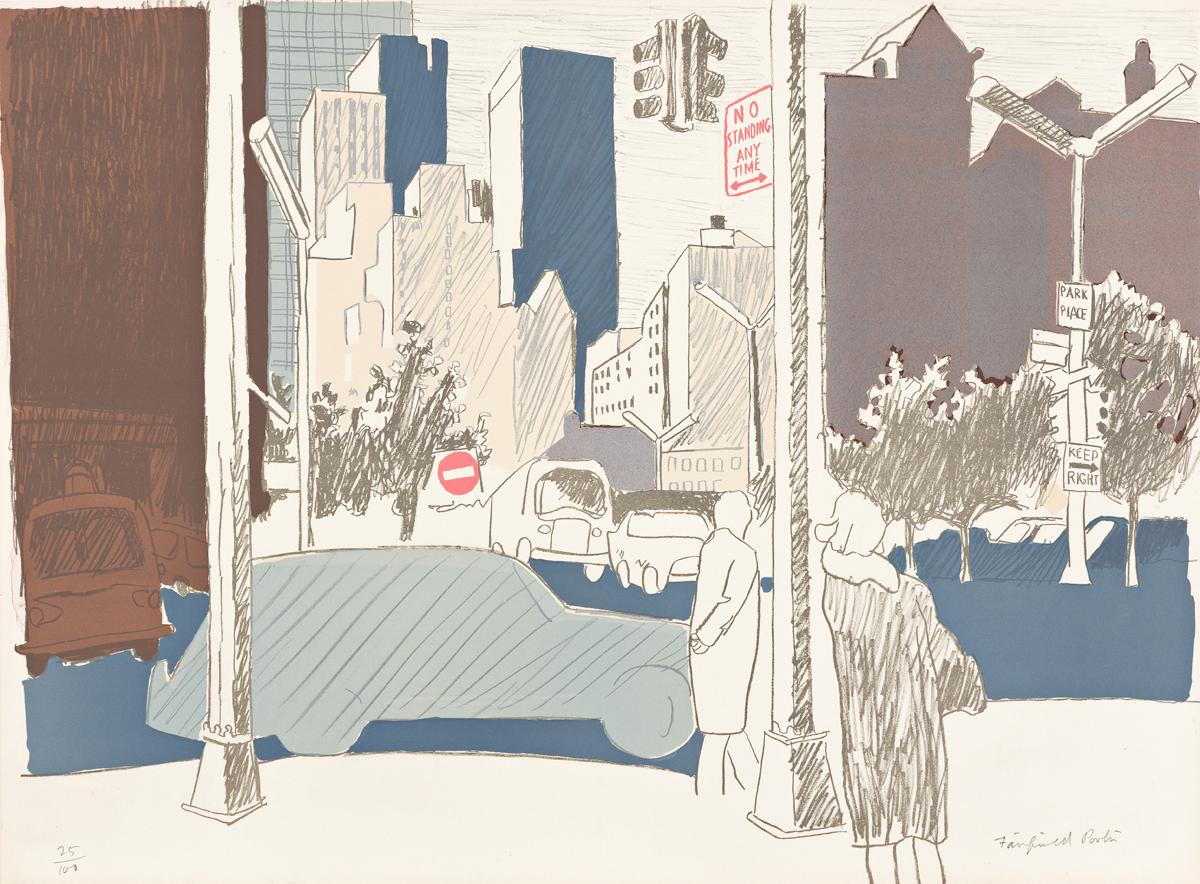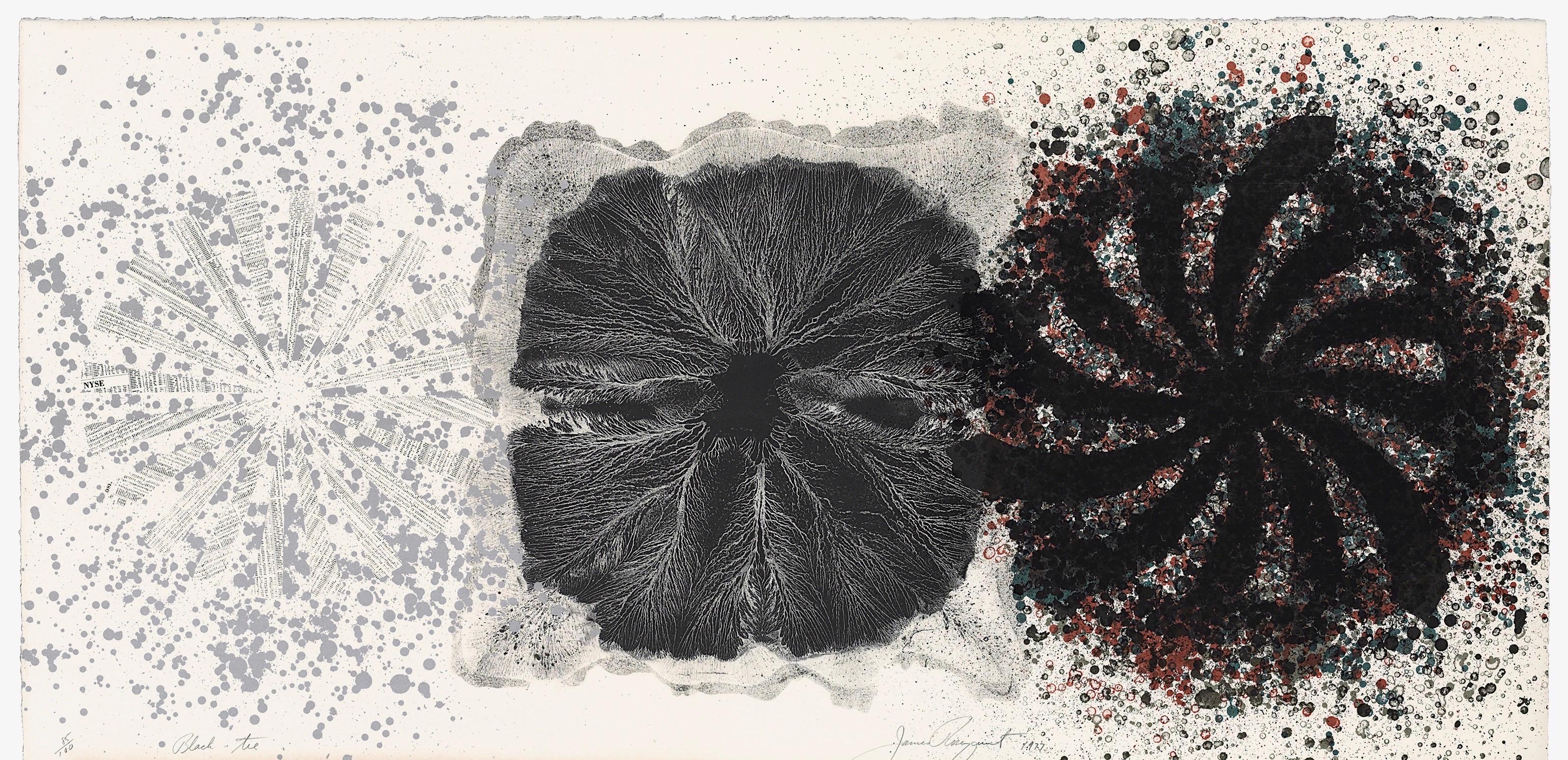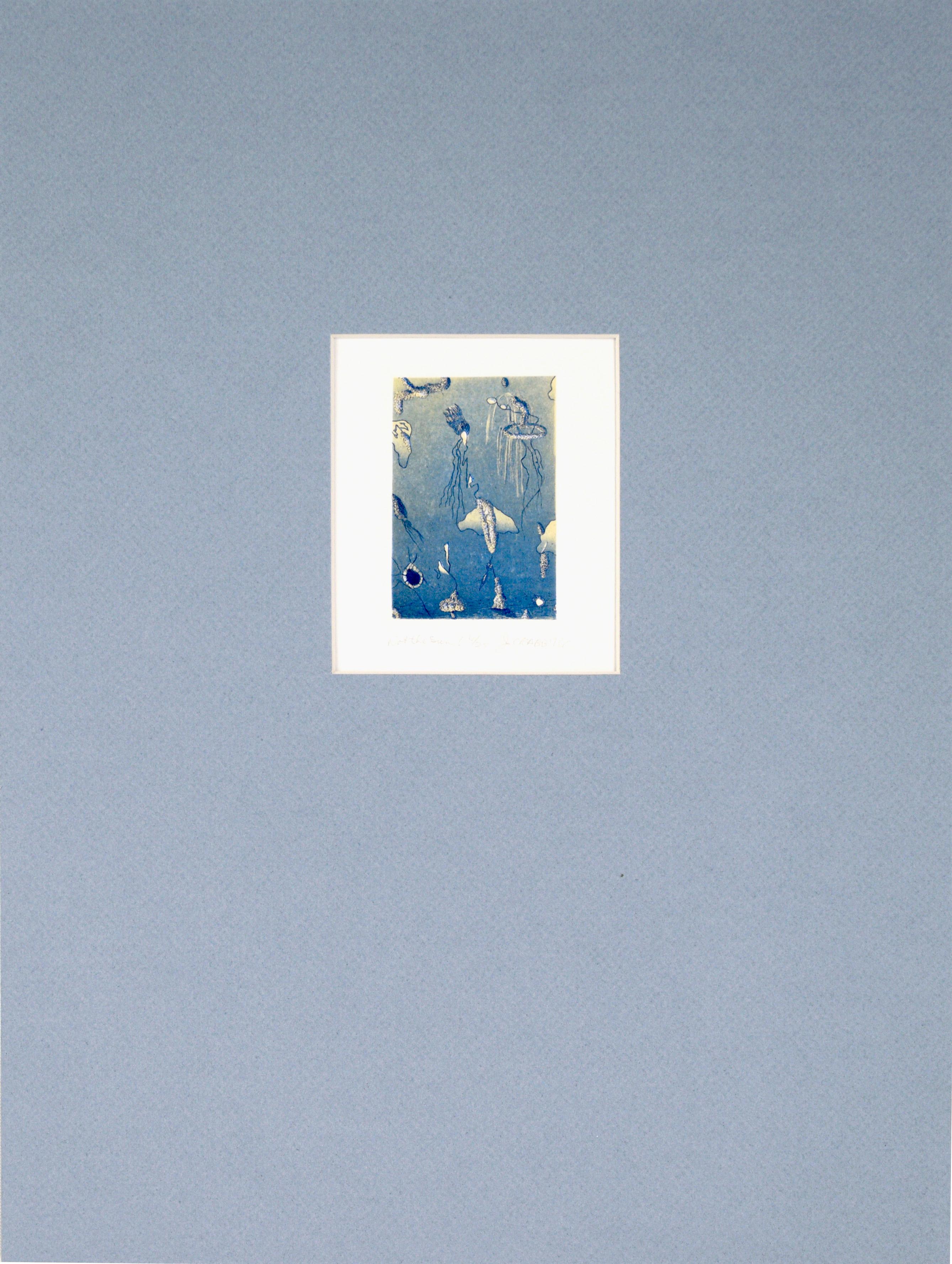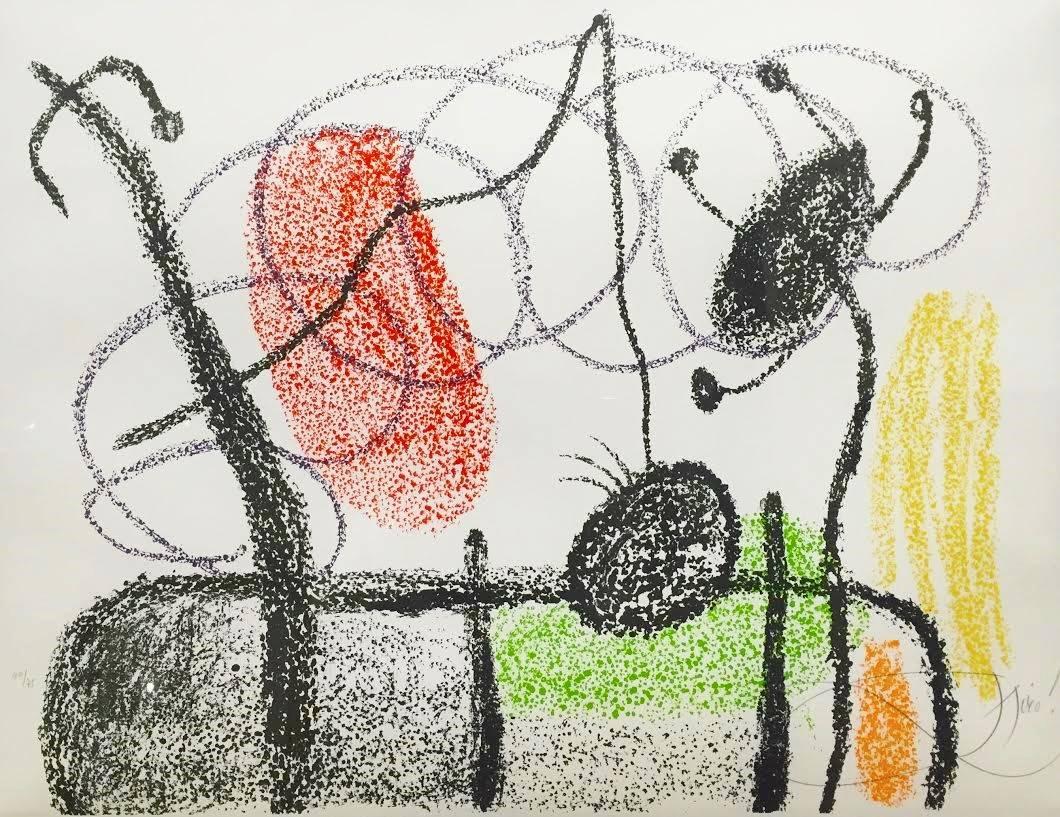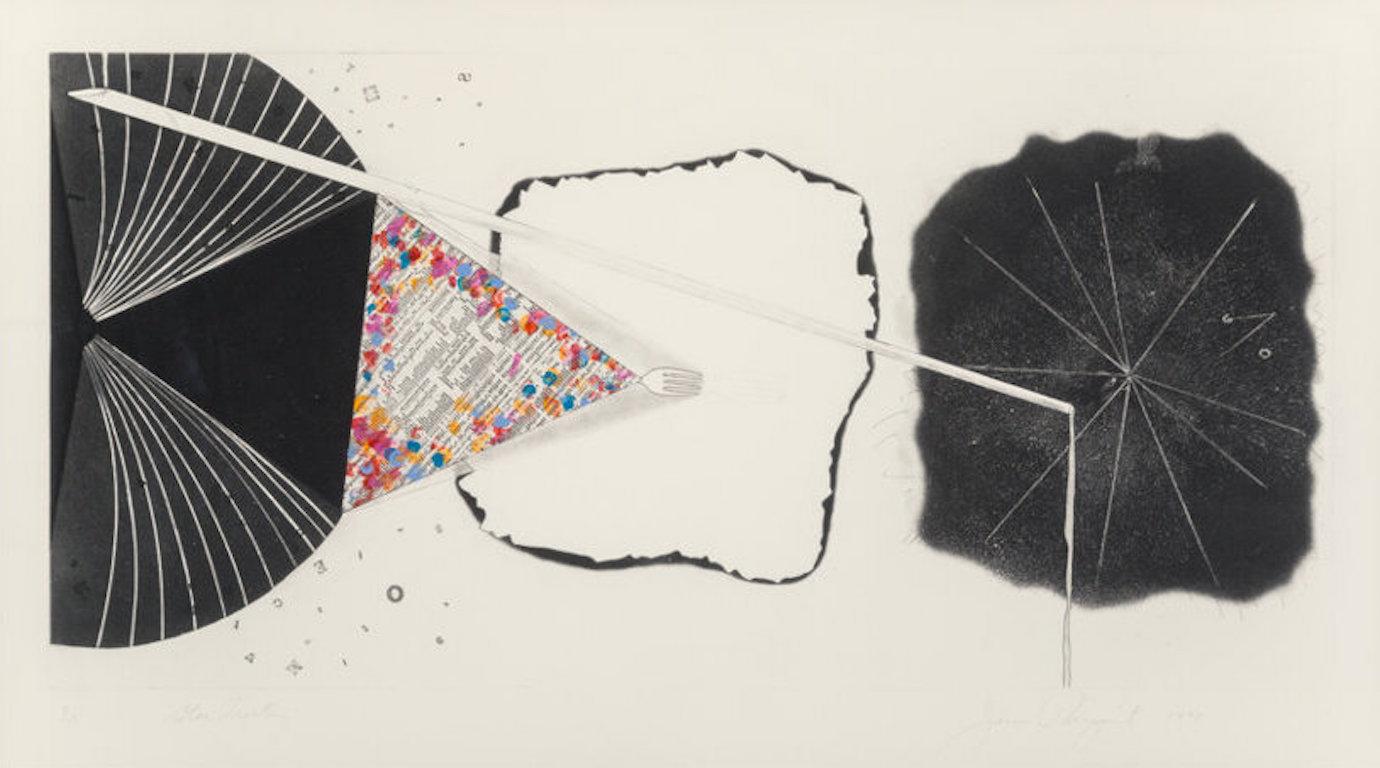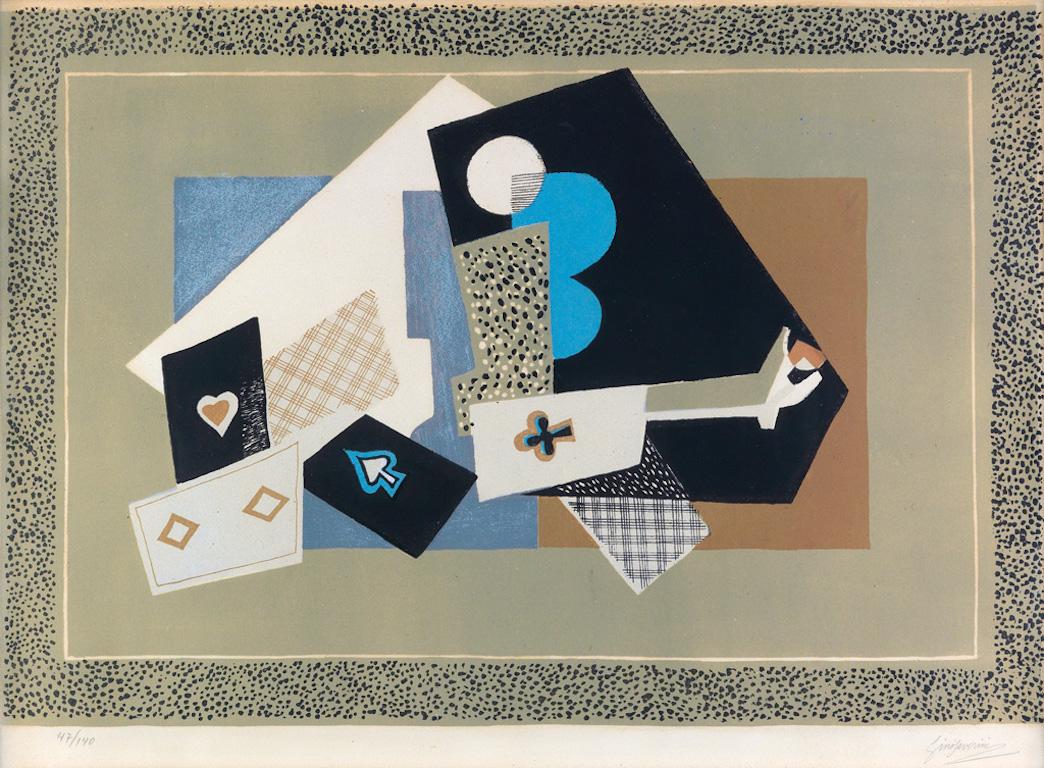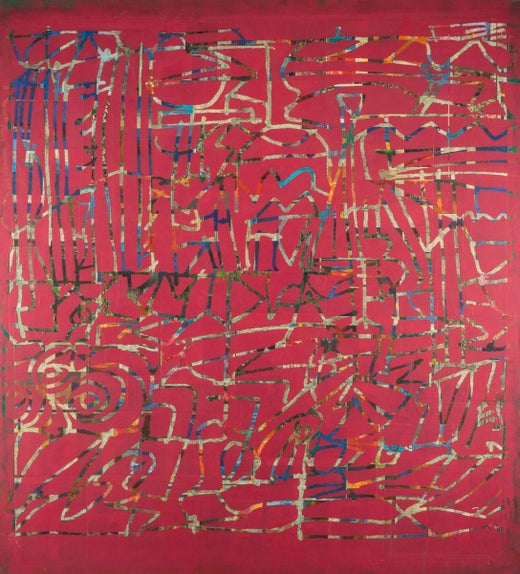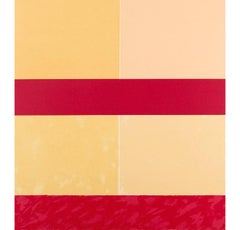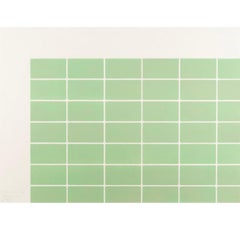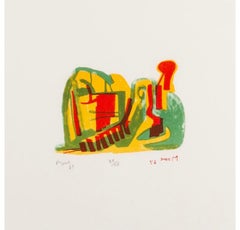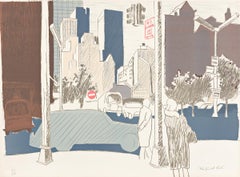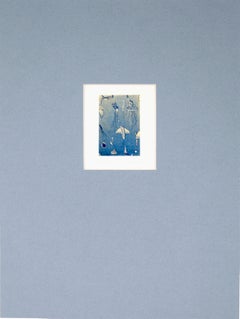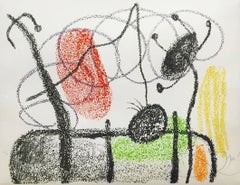Items Similar to Hornsey, 1957 - Abstract Lithograph Print in Bright Red and Blue
Want more images or videos?
Request additional images or videos from the seller
1 of 5
Gordon HouseHornsey, 1957 - Abstract Lithograph Print in Bright Red and Blue1957
1957
About the Item
Gordon House was born in 1932 in Pontardawe, South Wales. Early exposure to art on trips to the Glynn Vivian Art Gallery as a young boy inspired House towards creative endeavors and at the age of fourteen he was awarded a grant to enter art school which he accepted. From 1947 to 1950 he studied at Luton School of Art, Bedfordshire, and St. Albans School of Art, Hertfordshire. House's contemporaries included Richard Smith and John Plumb with whom he remained close. During the early fifties, after finishing art school, House began work as assistant to the ecclesiastical sculptor Theodore Kern. He also spent time at an advertising studio where he honed his burgeoning skills in typography and graphic design. In 1952 House was offered the position of designer for Imperial Chemical Industries Plastics Division where he stayed until 1959. This was followed by two years spent as graphic designer for the Kynoch Press in London. In 1961 House set out on his own as a self-employed designer and typographer. Initially this was supplemented by part-time teaching at art schools in and around London but by 1964 House was able to devote himself entirely to his design work which freed up valuable time to concentrate on his own artistic output in the studio.
In the late fifties, informed by the new art emerging from America and that of his contemporaries in England, House began to create large-scale abstract works which he was invited to show in 1959 at Dennis Bowen's legendary New Vision Centre in Marble Arch.
House was an active participant in the vibrant London art scene of the sixties, regularly attending lectures, exhibitions and discussions. In 1960 he exhibited in 'Situation' the key abstract exhibition of the decade held at the RBA Galleries. Other participating artists included Robyn Denny, Bernard and Harold Cohen, Gillian Ayres, John Hoyland, Richard Smith and William Turnbull among others. These artists, united by a common admiration for American Abstract Expressionism, were frustrated by the lack of exposure given to large-scale abstract works in commercial galleries so they organised their own exhibition. The name was derived from the participants' idea that an abstract painting that occupied the whole field of vision would involve the spectator in an 'event' or 'situation'. This exhibition was followed by 'New London Situation' in 1961 and a nationwide touring Arts Council presentation in recognition of the significance of the two earlier shows.
In 1961 House began producing his first prints at the Kelpra Studio, run by Chris and Rose Prater, where he made the earliest fine art screenprint ever to be produced in Britain. Artists such as Paolozzi and Hamilton followed in his footsteps and together they started a printmaking revolution in Britain. They cemented the medium of the screenprint in the world of fine art as opposed to the commercial sphere and secured the reputation of Kelpra in the process. Later, together with Cliff White, House set up the White Ink (Ltd.) print studio in London, where he produced etchings and wood engravings on a series of magnificent antique printing presses he had collected. White Ink soon gained a reputation for innovative and high quality printmaking, attracting artists such as R. B. Kitaj, Richard Smith, Joe Tilson, Sidney Nolan, Victor Pasmore, Eduardo Paolozzi, Bernard Cohen and Elizabeth Frink.
Printmaking was to remain a key part of House's oeuvre throughout the rest of his career, whether in the medium of screenprint, etching, woodcut, linocut or lithograph. In 1981 a retrospective exhibition of his graphic works opened at the Carnegie Institute, Pittsburgh, and in 1982 this travelled to the Brooklyn Museum, New York. These shows were instrumental in bringing House's prints to the attention of a wider American audience.
- Creator:Gordon House (1932, British)
- Creation Year:1957
- Dimensions:Height: 14.97 in (38 cm)Width: 22.05 in (56 cm)
- Medium:
- Period:
- Condition:
- Gallery Location:Kingsclere, GB
- Reference Number:1stDibs: LU2718215351012
Gordon House
The Guardian wrote of Gordon House, upon his death in 2004: Many of the works made during his last years by the painter and graphic designer Gordon House, who has died aged 71, referred back to his birthplace in the Swansea valley. He spent his earliest years in the steel town of Pontardawe. In Tin-pan Valley, the memoir he published earlier this year, he recalled "the clamour of steel mills ... the tinplate works and pithead gear" and "dynamite blasting as coal seams were struck higher up the valley". Unemployment and the depression of the 1930s led Gordon's parents to take him from the valleys of south Wales to the order and designed coherence of Letchworth, "Hertfordshire's first garden city". After leaving school at 14, he went to study, first, at Luton School of Art. For a while after that, he worked in a hospital, before, with the aid of a scholarship, moving on to St Albans School of Art. By 1961, Gordon had become established among a new generation of artists as an independently minded and adventurous painter and designer. The previous year, he had shown his large, bold, hard-edged canvasses at the important London "Situation" exhibition of large-scale abstract painting, and had designed the catalogue for that exhibition. As the 1960s moved on, Gordon designed for the pop world. He worked for the Beatles, designing their White album and the back of the Sergeant Pepper album, for which his longtime friend Peter Blake designed the front. Later, he designed Wings' first album. He delighted in the creative energy of others, and so could respond to the talents of musicians and artists alike. Gordon made paintings throughout his life as a designer. During the 1960s and 70s, his canvasses and prints reflected the dramatic tensions of his graphic design; by the 1980s, Wales had become his constant subject matter. The surface, texture and colour of his paintings softened. No doubt, he needed to pay homage to the places and the people who had shaped him, just as he always paid homage to the artists for whom he designed. His canvasses reduced in size, becoming palm-of-the-hand landscapes. He spent much time in Wales and, in his final years, he used his brush to walk a path through memories of collieries, valleys, smoking stacks, rows of cottages and the people who had first nurtured him.
About the Seller
No Reviews Yet
Vetted Professional Seller
Every seller passes strict standards for authenticity and reliability
1stDibs seller since 2024
36 sales on 1stDibs
Typical response time: 11 hours
- ShippingRetrieving quote...Shipping from: Kingsclere, United Kingdom
- Return Policy
Authenticity Guarantee
In the unlikely event there’s an issue with an item’s authenticity, contact us within 1 year for a full refund. DetailsMoney-Back Guarantee
If your item is not as described, is damaged in transit, or does not arrive, contact us within 7 days for a full refund. Details24-Hour Cancellation
You have a 24-hour grace period in which to reconsider your purchase, with no questions asked.Vetted Professional Sellers
Our world-class sellers must adhere to strict standards for service and quality, maintaining the integrity of our listings.Price-Match Guarantee
If you find that a seller listed the same item for a lower price elsewhere, we’ll match it.Trusted Global Delivery
Our best-in-class carrier network provides specialized shipping options worldwide, including custom delivery.More From This Seller
View AllUntitled by Mark Lancaster, 1967
By Mark Lancaster
Located in Kingsclere, GB
Untitled by Mark Lancaster, 1967
Additional information:
Medium: lithograph
73 x 63.5 cm
28 3/4 x 25 in
signed
Mark Lancaster was born Christopher Ronald Mark Lancaster, but early in life he decided that "Mark" was his favorite of the three names. Educated at Holme Valley Grammar School, 1949–52, and Bootham School, York, from 1952 to 55, after which he worked in a family textile business and studied textile technology for six years, painting in his own time, before going to King's College, Newcastle in 1961 to study Fine Art. From 1961 to 1965 Mark Lancaster studied under Richard Hamilton at the University of Newcastle upon Tyne, where he also taught from 1965–66, and then at the Bath Academy of Art, Corsham, Wiltshire, 1966–68, while living in London. He first visited New York City in 1964, where he worked briefly as an assistant to Andy Warhol, appeared in several Warhol movies, and met Jasper Johns, Ray Johnson, Ellsworth Kelly, Roy Lichtenstein, Frank Stella, James Rosenquist, Larry Rivers, Frank O'Hara, Robert Motherwell, Helen Frankenthaler, Norman Mailer and many others. In New York he photographed extensively, and started a series of paintings related to the imagery of the Howard Johnson...
Category
20th Century Abstract Prints
Materials
Lithograph
Desert Forms, from Aegean Suite by Barbara Hepworth, 1971
By Barbara Hepworth
Located in Kingsclere, GB
Desert Forms, from Aegean Suite by Barbara Hepworth, 1971
Additional information:
Medium: lithograph with embossing
81 x 59 cm
31 7/8 x 23 1/4 in
signed
Barbara Hepworth was one of...
Category
20th Century Abstract Prints
Materials
Lithograph
Zapruder Green by Mark Lancaster, 1968
By Mark Lancaster
Located in Kingsclere, GB
Zapruder Green by Mark Lancaster, 1968
Additional information:
Medium: lithograph
55.9 x 76.8 cm
22 x 30 1/4 in
signed
Mark Lancaster was born Christopher Ronald Mark Lancaster, but early in life he decided that "Mark" was his favorite of the three names. Educated at Holme Valley Grammar School, 1949–52, and Bootham School, York, from 1952 to 55, after which he worked in a family textile business and studied textile technology for six years, painting in his own time, before going to King's College, Newcastle in 1961 to study Fine Art. From 1961 to 1965 Mark Lancaster studied under Richard Hamilton at the University of Newcastle upon Tyne, where he also taught from 1965–66, and then at the Bath Academy of Art, Corsham, Wiltshire, 1966–68, while living in London. He first visited New York City in 1964, where he worked briefly as an assistant to Andy Warhol, appeared in several Warhol movies, and met Jasper Johns, Ray Johnson, Ellsworth Kelly, Roy Lichtenstein, Frank Stella, James Rosenquist, Larry Rivers, Frank O'Hara, Robert Motherwell, Helen Frankenthaler, Norman Mailer and many others. In New York he photographed extensively, and started a series of paintings related to the imagery of the Howard Johnson...
Category
20th Century Abstract Prints
Materials
Lithograph
Reclining Figure by Henry Moore, 1967
By Henry Moore
Located in Kingsclere, GB
Reclining Figure by Henry Moore, 1967
Additional information:
Medium: lithograph
30 x 30 cm
11 3/4 x 11 3/4 in
signed, dated and numbered in pencil; further signed and dated again i...
Category
20th Century Abstract Prints
Materials
Lithograph
Squares and Circles, from Twelve Lithographs by Barbara Hepworth, 1969
By Barbara Hepworth
Located in Kingsclere, GB
Squares and Circles, from Twelve Lithographs by Barbara Hepworth, 1969
Additional information:
Medium: lithograph
58 x 80 cm
22 7/8 x 31 1/2 in
signed and numbered in pencil
Barbar...
Category
20th Century Abstract Prints
Materials
Lithograph
Julian and Alexis by Howard Hodgkin 1977-1978
By Howard Hodgkin
Located in Kingsclere, GB
Julian and Alexis by Howard Hodgkin 1977-1978
Additional information:
Medium: lithograph in colours with hand-colouring on Arches
70 x 102 cm
27 1/2 x 40 1/8 in
signed, dated and numbered 19/30 in pencil
Hodgkin was born in London and grew up in Hammersmith Terrace. During World War II he was evacuated to Long Island, New York, for three years. In the Museum of Modern Art, New York, he saw works by School of Paris artists such as Henri Matisse, Édouard Vuillard, and Pierre Bonnard, which he could not easily have seen then in London or Paris. Back in England in 1943, Hodgkin ran away from Eton College and Bryanston School, convinced that education would impede his progress as an artist, though he encountered inspiring teachers at both schools. He then attended Camberwell School of Arts and Crafts (1949–50) and Bath Academy of Art, Corsham (1950–54).
Hodgkin never belonged to a school or group. While many of his contemporaries were drawn to Pop or the School of London, he remained independent, initially marking his outsider status with a series of portraits of contemporary artists and their families. His first solo exhibition was at Arthur Tooth and Sons in London in 1962. Two years later he first visited India, following his interest in Indian miniatures, which began during his time at Eton. Collecting Indian art would remain a lifelong passion, which he initially supported by dealing in picture frames.
In 1984 Hodgkin represented Britain at the Biennale di Venezia. His exhibition Forty Paintings reopened the Whitechapel Gallery, London, in 1985, and he won the Turner Prize the same year. In 1995–96 Hodgkin had an exhibition at the Metropolitan Museum of Art, New York, which travelled to the Modern Art Museum of Fort Worth, Texas; Kunstverein für die Rheinlande und Westfalen, Düsseldorf; and Hayward Gallery, London. His first full retrospective opened at the Irish Museum of Modern Art, Dublin, in 2006 and traveled to Tate Britain, London, and Museo Nacional Centro de Arte Reina Sofía, Madrid. In the autumn of 2016 Hodgkin visited India for what was to be the last time, completing six new paintings before his return to London. These works were shown at England’s Hepworth Wakefield in 2017, in Painting India, a show that focused on the artist’s long-standing relationship with the Indian subcontinent.
Starting in the 1950s, Hodgkin maintained a parallel printmaking practice, translating his visual language into works on paper. Exploring the interactions of color and space on a grander scale, he produced theatrical set designs for Ballet Rambert, the Royal Ballet, and the Mark Morris Dance Group. His black stone and white marble mural...
Category
20th Century Abstract Prints
Materials
Lithograph
Price Upon Request
You May Also Like
Street Scene
By Fairfield Porter
Located in New York, NY
Porter's first color lithograph. A very good impression on Arches with strong colors. Signed and numbered 25/100 in pencil. Printed by Mourlot, New York. Published by Brooke Alexande...
Category
1960s Abstract Expressionist Landscape Prints
Materials
Color, Lithograph
Large American Pop Art Color Abstract Lithograph "Black Tie" James Rosenquist
By James Rosenquist
Located in Surfside, FL
Black Tie, 1977
James Rosenquist, American, 1933–2017.
Printed by Maurice Sanchez at Derrière L'Étoile Studios, Inc.
Published by Sidney Singer
Color lithograph on rolled white Arches Cover paper
Blindstamp of a man in a hat, bottom right
Hand signed in pencil. Dated 1977 lower right. Titled and numbered 76/100 lower left.
Measures 73 1/2" x 37
James Rosenquist (November 29, 1933 – March 31, 2017) was an American artist and one of the proponents of the pop art movement. Drawing from his background working in sign painting, Rosenquist's pieces often explored the role of advertising and consumer culture in art and society, utilizing techniques he learned making commercial art to depict popular cultural icons and mundane everyday objects. While his works have often been compared to those from other key figures of the pop art movement, such as Andy Warhol, JIm Dine and Roy Lichtenstein, Rosenquist's pieces were unique in the way that they often employed elements of surrealism using fragments of advertisements and cultural imagery to emphasize the overwhelming nature of ads. He was a 2001 inductee into the Florida Artists Hall of Fame.
Rosenquist was born on November 29, 1933, in Grand Forks, North Dakota, the only child of Louis and Ruth Rosenquist. His parents were amateur pilots of Swedish descent who moved from town to town to look for work, finally settling in Minneapolis, Minnesota. His mother, who was also a painter, encouraged her son to have an artistic interest. In junior high school, Rosenquist won a short-term scholarship to study at the Minneapolis School of Art and subsequently studied painting at the University of Minnesota from 1952 to 1954. In 1955, at the age of 21, he moved to New York City on scholarship to study at the Art Students League, studying under painters such as Edwin Dickinson and George Grosz. Talking about his experience at the Art Students League, Rosenquist said "I studied only with the abstract artists. They had commercial artists there teaching commercial work, I didn't bother with that. I was only interested in -- see, here's how it started. I was interested in learning how to paint the Sistine Chapel. It sounds ambitious, but I wanted to go to mural school". While studying in New York, Rosenquist took up a job as a chauffeur, before deciding to join the International...
Category
1970s Pop Art Abstract Prints
Materials
Lithograph, Color
"Not the sun!" - 1976 Surrealist Lithograph on Paper
Located in Soquel, CA
"Not the sun!" - 1976 Surrealist Lithograph on Paper
1976 surrealist lithograph on paper titled "Not the sun!" by Jim Crabb (American, b. 1947). This piece resembles a surreal ocean...
Category
1970s Surrealist Abstract Prints
Materials
Laid Paper, Lithograph
Joan Miró, Plate 19 from Album 21, lithograph
By Joan Miró
Located in Chatsworth, CA
An original lithograph by Joan Miro, created in 1978, from the series entitled "Album 21" consisting of 21 original lithographs. Hand signed and numbered from the edition of 75 on V...
Category
1970s Abstract Abstract Prints
Materials
Lithograph
James Rosenquist 'Star Proctor' Signed, Limited Edition Print
By James Rosenquist
Located in San Rafael, CA
James Rosenquist (1933-2017)
Star Proctor, 1978
Etching and aquatint in colors with embossment and hand embellishment on Pescia Italia paper
Edition 11/78
Signed, numbered, dated, and titled in pencil along lower edge
Published by Multiples Inc., New York
Printed by Flatstone Studio, Tampa, Florida
Framed Dimensions 31in H X 48in L
LITERATURE: Glenn, 130
Rosenquist's work is included in major public and private institutions, and has been featured in solo exhibitions at the Solomon R. Guggenheim Museum, Museum of Modern Art, Walker Art Center, Whitney Museum of American Art, Guggenheim Museum Bilbao, The Menil Collection...
Category
1970s Abstract Abstract Prints
Materials
Etching, Lithograph
$2,800 Sale Price
20% Off
Nature Morte
By Gino Severini
Located in New York, NY
A very good impression of this color lithograph with strong colors. Signed and numbered 119/140 in pencil by Severini. Printed by Michael Cassé, Paris. Published by L'Œuvre Gravée, P...
Category
1950s Futurist Abstract Prints
Materials
Color, Lithograph
Recently Viewed
View AllMore Ways To Browse
Antique Print House
Vintage House Keys
Antique Art Print Sets
Early American New England Antiques
Gordon Woods
Arch Industries
Vintage Art Plastics
William Rose Antiques
Red Marble 1960
Blue John Marble
Pablo Picasso Original Inc Sketch
Panem Nostrum Dali Print
Paul De Longpre Vintage Prints
Paul Emile Lecomte Etching
Paul Suttman
People With Umbrellas Garden Fountain
Perennial Calendar
Peter Chan
